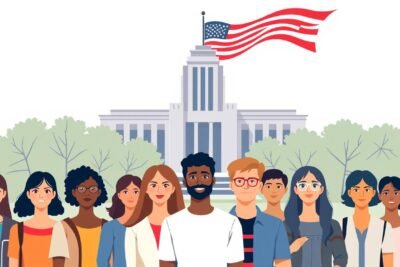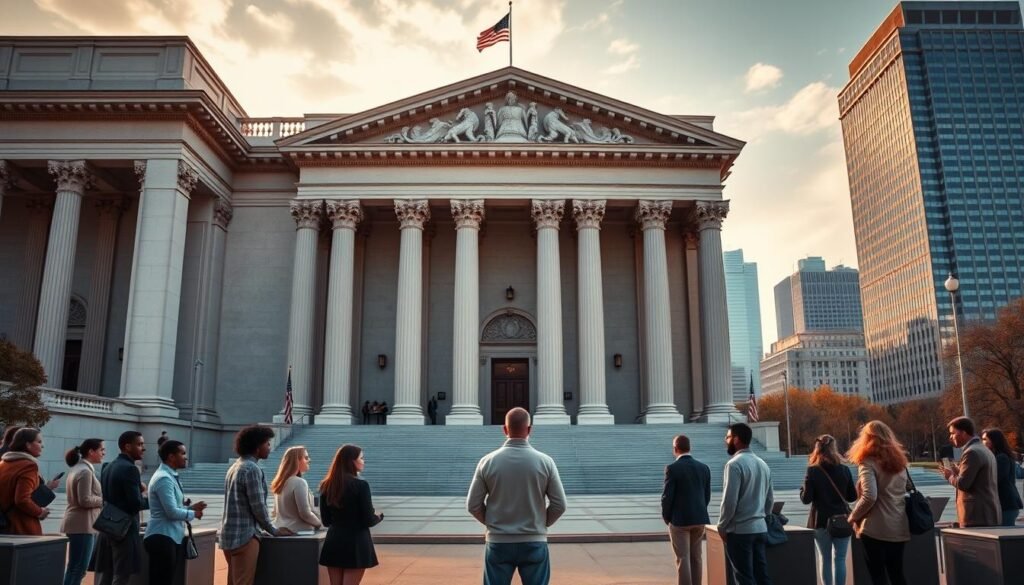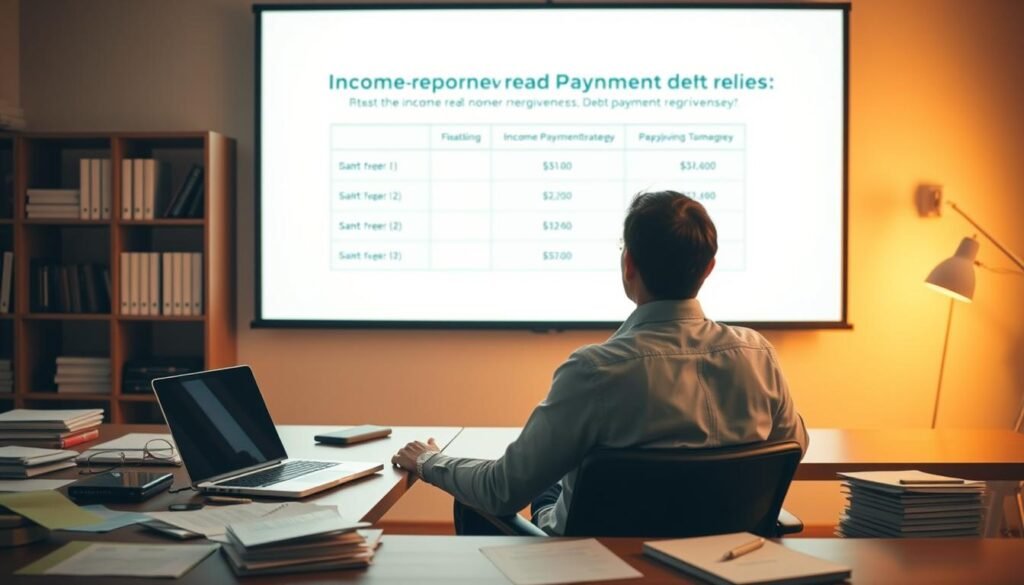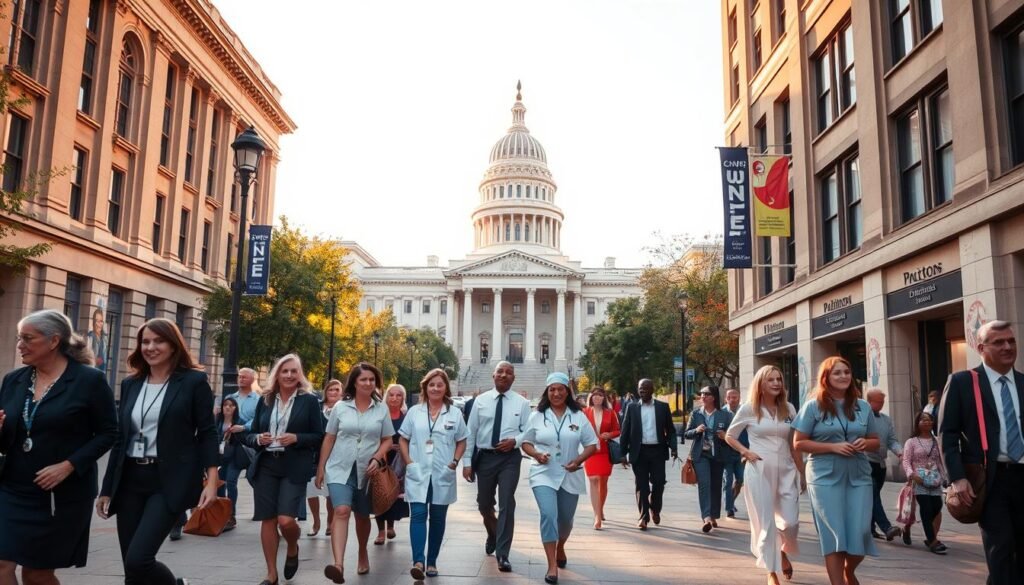
Federal Loan Forgiveness Program USA: Your Path to Debt Relief

Imagine opening your mailbox and finding a note that says your student debt can shrink or disappear. You breathe out. That moment can turn stress into a plan.
You’ll learn clear steps to match your student loan type with the right option. Some paths cut balances after years of payments while others erase debt faster for public service or teaching.
We’ll show how income-driven plans can lower payments, how PSLF rewards qualifying nonprofit work, and when a loan discharge can even return past payments. You’ll also get warnings about refinancing with private lenders and costly paid “relief” offers.
Start by checking which loans you have and your employer type. For a helpful guide on the repayment system and forgiveness options, see this repayment overview.
By the end of this article, you’ll know the first forms to file and how to track payments so you don’t waste time chasing the wrong path.
- Start here: Your quickest paths to student loan forgiveness and relief
- Income-driven repayment plans: Lower payments today, forgiveness tomorrow
- Public service and education paths: PSLF, Teacher Loan Forgiveness, and nursing options
- Discharge programs available for extreme situations
- Loan repayment assistance programs beyond federal forgiveness
- federal loan forgiveness program USA vs. private student loan options
- Your next steps to lighter student loan bills
Start here: Your quickest paths to student loan forgiveness and relief
Begin with options that lower your payment today and keep your path to student loan forgiveness on track.
You can get immediate relief by switching to income-driven repayment plans. IDR caps payments by income and family size and can drop your monthly bill to as low as $0. These plans forgive any remaining loan balance after 20 or 25 years, depending on the plan.
If you work in qualifying public service, Public Service Loan Forgiveness may erase remaining debt after 120 qualifying payments while on IDR. For teachers in low-income schools, Teacher Loan Forgiveness can forgive up to $17,500 after five consecutive years.

When discharge fits better than forgiveness
Closed-school discharge and borrower defense can wipe out debt sooner and may refund past payments when a school closes or misled you. If that matches your situation, pursue discharge first — it can be faster than waiting years for forgiveness.
If you need help now: repayment assistance and consolidation
Federal consolidation can extend terms to 30 years to lower monthly amounts. Deferment or forbearance can pause payments but watch for interest accrual. Always contact your student loan servicer for forms and timelines, and keep records of approvals.
- Use the government loan simulator and start with IDR for lower monthly payments fast.
- Certify public-service employment yearly if pursuing PSLF and track qualifying payments.
- Avoid refinancing to private creditors if you want to preserve eligibility for forgiveness options.
Income-driven repayment plans: Lower payments today, forgiveness tomorrow
If monthly payments feel out of reach, income-driven plans can tie costs to what you actually earn.
How IDR caps payments and leads to forgiveness in 20–25 years
IDR sets your monthly student loan payment as a share of your discretionary income. That cap keeps your bills predictable and often reduces them compared with standard schedules.
After 20 or 25 years on an IDR plan, any remaining loan balance becomes eligible for student loan forgiveness. Through 2025, that forgiveness is treated as tax-free at the federal level, which can matter when your remaining loan balance is cleared.
Who benefits most and when payments can be $0
Borrowers with high student loan debt relative to earnings get the biggest relief. If your income is low, your payment can drop to $0, and every $0 month still counts toward loan repayment and the timeline to loan forgiveness.

Apply online at StudentAid.gov/IDR and pick the plan that fits you. Then contact your student loan servicer to certify income each year and track qualifying payments.
- Use IDR to secure lower monthly payments while you rebuild finances.
- Keep annual recertifications on time and save confirmations from your servicer.
- For news on repayment pauses and updates, see this repayment plans suspended article.
Public service and education paths: PSLF, Teacher Loan Forgiveness, and nursing options
Working in government, nonprofit, or a qualifying school can change how your student debt is handled.
Public Service Loan Forgiveness (PSLF) erases remaining balances after 120 qualifying payments while you are on an IDR plan and working full time for qualifying employers.
PSLF for government and nonprofits
PSLF gives tax-free relief after 10 years of qualifying service and payments. Make sure your federal student loans are Direct Loans or consolidated into one.
File the PSLF Help Tool yearly and keep employer certification forms to preserve credit for qualifying payments.
Teacher Loan Forgiveness for low-income schools
If you teach full time in a qualifying low-income public school for five consecutive years, you may get up to $17,500 under teacher loan forgiveness.
You can claim this first and then pursue PSLF for any remaining balance to maximize relief.
Nurses: stacked options and targeted repayment aid
Nurses may use PSLF, explore Perkins loan cancellation if they held a Perkins loan, and apply to the NURSE Corps Loan Repayment Program, which can pay up to 85% of eligible debt but is competitive.
"Certify employment annually and count each qualifying payment to protect your path to full relief."

| Path | Who it helps | Key benefit |
|---|---|---|
| PSLF | Government & qualifying nonprofits | Tax-free discharge after 120 qualifying IDR payments |
| Teacher Loan Forgiveness | Full time low-income public school teachers | Up to $17,500 after five years |
| NURSE Corps / Perkins | Nurses and former Perkins borrowers | Up to 85% repayment (NURSE Corps); cancellation over years for Perkins |
| Stacking strategy | Education professionals | Claim teacher benefit first, then continue to PSLF for remaining balance |
- Use IDR and Direct Consolidation so each month counts toward PSLF.
- Confirm employer eligibility and track qualifying payments to avoid lost credit.
- Balance earlier teacher relief versus longer PSLF payoff to pick what suits you best.
Discharge programs available for extreme situations
There are special discharge options for extreme cases that can cancel your balance and sometimes refund payments.
Closed school discharge applies if your school shut down while you were enrolled or within 180 days after you withdrew and you did not receive a degree.
Approvals can refund past payments. Apply quickly and keep paying until you get a decision.
Borrower defense to repayment
If a school misled you, borrower defense can wipe out what you owe. File a detailed claim and save evidence.
Watch for legal updates, since approvals may be paused by court orders even though discharge programs available remain in place.
Perkins loan cancellation and public service
Staff in qualifying public service or teaching roles may get perkins loan cancellation over several years.
Some professions see a percentage discharged each year, sometimes reaching 100%.
Total and permanent disability and death
Total permanent disability discharge clears debt with medical, SSA, or VA proof and includes a three-year monitoring period.
Veterans who are totally permanently disabled may get automatic discharges unless they opt out due to state tax concerns.
Federal student loans are also discharged on death after a death certificate is submitted; Parent PLUS loans qualify when the parent or the student dies.
"Keep copies of every form and contact student loan servicers right away clear records speed decisions."
| Case | Who may qualify | Key outcome |
|---|---|---|
| Closed school | Students enrolled at closing | Loans discharged; possible refunds |
| Borrower defense | Misled students | Loan discharge if proven |
| Perkins cancellation | Public service & teachers | Partial to full discharge over years |
| Total permanent disability | Totally permanently disabled borrowers | Loans discharged; monitoring period |
- Discharges can be faster than long-term loan forgiveness and may return past payments.
- Contact student loan servicers, submit proof, and keep records to protect your case.
Loan repayment assistance programs beyond federal forgiveness
Beyond federal options, many local and workplace plans give direct help to pay down student debt.
State-based aid for teachers, nurses, doctors, and lawyers
Many states run loan repayment assistance that targets specific careers. You can find teacher loan and health-care incentives through your state higher education agency.
Example: Mississippi’s Winter-Reed Teacher Loan Repayment can pay up to $6,000 per year for qualifying teachers in certain subjects or locations.
Some offers pair with perkins loan cancellation if you held a Perkins loan, multiplying relief for public-service roles.
The military often provides generous repayment assistance. The National Guard and other branches may offer up to $50,000 in a loan repayment program if you may qualify based on service and job.
Check rules by branch and role. Service commitments and tax rules can vary, so compare options before you sign.
National organizations and employer student loan repayment assistance
National groups like the NIH pay large awards sometimes up to $50,000 a year for eligible researchers. Employers also increasingly offer monthly contributions that help shrink your balance.
Some repayment assistance covers private student loan debt, but terms differ. Ask HR what they offer and whether they will apply payments directly to your account.
- Check your state agency for targeted loan repayment assistance for teachers, nurses, doctors, and lawyers.
- Explore military options branches may provide significant repayment assistance if you may qualify.
- Ask employers about student loan benefits and confirm eligible loan types, including private student loan coverage.
| Source | Who it helps | Typical benefit |
|---|---|---|
| State agencies | Teachers, healthcare, lawyers | Up to $6,000/year (example) |
| Military | Enlisted & officers | Up to $50,000 (varies by branch) |
| National/Employer | Researchers & employees | NIH: up to $50,000; employer monthly payments |
"Stack state, military, and employer repayment assistance with IDR or public service plans to cut the time you spend paying."
federal loan forgiveness program USA vs. private student loan options
Before you chase a lower rate, understand what protections you might give up when moving private debt.
Why most private student loans don’t qualify for forgiveness
Most relief paths apply to federal student loans. Private student loan accounts rarely offer the same cancellation options.
Exceptions are usually limited to death or permanent disability per lender policy. That means if you refinance federal debt into private, you can lose income-driven plans and PSLF benefits.
Refinancing private loans: fixed APRs, min. credit score, and NerdWallet context
Refinancing can lower your rate. Market snapshots show rating fixed apr bands like 2.89%-17.99% or 3.69%-14.41% and some lists note 4.45%-14.9% ranges.
Most offers need a min. credit score in the mid-600s. Some products reference 9.99 min. credit tiers. Editorial roundups often tag lenders with a 4.5 NerdWallet rating or similar labels to compare options.
What to ask your private lender about deferment and hardship help
Ask about deferment, forbearance, interest-only periods, and how autopay affects your rate.
Also confirm fees, prequalification tools, and whether employer or state loan repayment assistance can be applied to private accounts.
"If you mix federal and private debt, treat refinancing as a trade-off: lower rate versus lost protections."
Your next steps to lighter student loan bills
Start with a simple checklist to cut monthly student loan bills this month.
Pick one clear path: apply for IDR to lower payments now, or certify public‑service work so your time counts toward loan forgiveness. If you teach in a time low‑income public school, file teacher loan paperwork and then continue toward PSLF if you remain full time low‑income.
Need faster relief? Review discharge programs available borrower defense, closed‑school, or total permanent disability and act quickly so you may qualify without delay.
Consider consolidation to keep loans in the federal system and extend terms to 30 years, but use deferment or forbearance sparingly since interest may accrue. If in default, pursue rehabilitation or consolidation first.
Combine employer or state repayment assistance with other options and always contact student loan servicer support, keep copies of forms, and set reminders. For an overview of the repayment system and steps to take next, see this repayment overview.
If you want to know other articles similar to Federal Loan Forgiveness Program USA: Your Path to Debt Relief you can visit the category Federal.




Leave a Reply